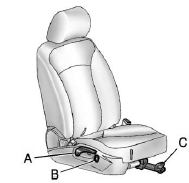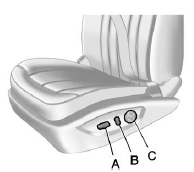Seat Adjustment
Manual Seats

A. Seatback Recline Lever
B. Height Adjustment Switch
C. Seat Position Handle
To adjust the seat position:
1. Pull the handle (C) under the front of the seat cushion.
2. Slide the seat to the desired position and release the handle.
3. Try to move the seat back and forth to be sure it is locked in place.
Press and hold the top or bottom of the switch (B) to raise or lower the seat. Release the switch when the desired height is reached.
To raise or recline the seatback, use the lever (A) on the outboard side of the seat. See Reclining Seatbacks.
Power Seats

A. Power Seat Adjustment Control
B. Reclining Seatbacks
C. Lumbar Adjustment
To adjust a power seat, if equipped:
► Move the seat forward or rearward by sliding the control (A) forward or rearward.
► Raise or lower the front or rear part of the seat cushion by moving the front or rear of the control (A) up or down.
► Raise or lower the entire seat by moving the control (A) up or down.
See Power Seat Adjustment for more information.
To raise or recline the seatback, tilt the top of the control (B) forward or rearward. See Reclining Seatbacks.
Press the front or rear of the control (C) to increase or decrease lumbar support. See Lumbar Adjustment.
See also:
Immobilizer Operation (Key Access)
This vehicle has a passive
theft-deterrent system.
The system does not have to be
manually armed or disarmed.
The vehicle is automatically
immobilized when the key is
removed from the igniti ...
Cooling System
The cooling system allows the engine to maintain the
correct working temperature.
3.9L Engine
A. Coolant Recovery Tank
B. Radiator Pressure Cap
C. Electric Engine Cooling Fans
4.6L Engine
...
Add-On Electrical Equipment
Notice: Do not add anything electrical to the vehicle
unless you check with your dealer/retailer first. Some
electrical equipment can damage the vehicle and the
damage would not be covered by th ...


